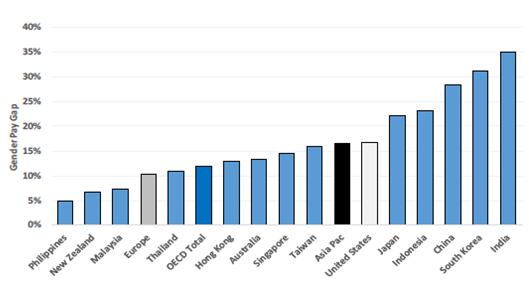Womanity 2.0
Le differenze di genere sono ancora fortemente diffuse nella società in cui viviamo. I temi su cui le aziende di tutto il mondo stanno maggiormente progredendo sono la parità salariale, i congedi parentali, la promozione di una cultura inclusiva e non discriminatoria, nonché la presenza di politiche contro ogni tipo di discriminazione di genere.
Leggi l'articolo in inglese
Womanity 2.0
Gender inequality is still widespread at all levels of our society. The availability of data on gender equality continues to gradually improve, with an encouraging shift to consider dynamics beyond board representation. This includes how companies are addressing the gender pay gap, parental leave, promotion of an inclusive culture and anti-sexual harassment policies.
“Mother penality”: lifetime of reduced earnings after firstborn
The gap between the earning power of men and women returning to work after having a child widens steadily: in the 12-years after having her first child, a woman’s hourly pay rate falls 33% behind man’s one (data from IFS: Institute for Fiscal Studies).
Over a 15-year period, women who took just one year off from work had annual earnings that were 30% lower than women who did not take time off (data from IFS: Institute for Fiscal Studies).
How the wage gap between men and women increases after having a child

Source: IFS
Another relevant data, which highlights the presence of gender inequalities even outside the workplace, is that women carry out at least 2.5x more unpaid care work than men. It was estimated by ILO (International Labour Organization) that it will take more than 200 years to close the gender gap in unpaid care work. The consequence of taking a far larger share of domestic and caring work is that women have less time to participate and make carrier in the traditional paid labor force.
Women do at least 2.5 times the unpaid work of men

Source: UN, ILO 2018
Woman in developed markets continue to delay parenthood
Women in DMs are delaying motherhood

Average age of women at birth of first child by region. Source: Euromonitor 2020
Another widely spread working inequality between men and women is the differences in their wages. For example, working women in the United States are paid, on average, more than US$11,000 less per year than men, which amounts to around 89 weeks of food expenses or more than one year of rent (source: BoFA Global Research).
The worrying data is that worse gender pay gaps overlap with low fertility rates even in some richer advanced countries, as shown in the plot below by BoFA Global Research:

To reduce and close gender gap, it is important that companies increase not only the woman presence in the working force, in the management, and at C level but also to give tools to woman to overcome the structural gender gap issues, such as:
- Gender pay gap action plan
- Parental leave: non transferrable use-it-or-lose-it”
- Childcare programs
- Female Leadership Program and action plan
- Sponsor STEM education programs for woman
- Promote inclusive culture to overcome stereotype gender bias
- Offer flexible work location
- Recruiting women after career break
In addition, women may also be less likely to get pay raises that keep up with inflation, since women make up 75% of the Healthcare & Education sectors, which saw the second lowest nominal wage increase across sectors in the US in 2022 (source: BLS).
Due to the rising childcare costs caused by the inflation, many women are indirectly kept, or pushed, out of the workforce.
To gain exposure to womanity themes, many companies started promoting programs and setting targets to avoid gender pay gap and improve gender diversity, also in managerial positions.
Progress towards gender equality in the workplace in the Asia-Pacific is slower than Europe and US but it is uneven among regions (for example, Australian companies performed best overall, while Japanese companies scored lowest).

Gender Representation in Asia-Pacific companies (source: Bofa Global Research)
Most companies (91%) in Asia-Pacific do not disclose any information on the differences between male and female salaries (compared to 83% globally). Philippines, New Zealand, and Malaysia lead on gender pay gap within Asia, while India, South Korea, and China lag the most. Compared to the rest of the world, Asia lags Europe on gender pay gap progress but is on par with the United States. Asia also tracks behind the OECD average.

Source: OECD, World Bank, United Nations, Country Agencies, BofA A PAC ESG Strategy
Disclaimer:
Nothing in this document is intended as investment research or as a marketing communication, nor as a recommendation or suggestion, express or implied, with respect to an investment strategy concerning the financial instruments managed or issued by Eurizon Capital SGR S.p.A.. Neither is this document a solicitation or offer, investment, legal, tax or other advice.
The opinions, forecasts or estimates contained herein are made with reference only to the date of preparation, and there can be no assurance that results or any future events will be consistent with the opinions, forecasts or estimates contained herein. The information provided and opinions contained are based on sources believed to be reliable and in good faith. However, no representation or warranty, express or implied, is made by Eurizon Capital SGR S.p.A. as to the accuracy, completeness or fairness of the information provided.
Any information contained in the present document may, after the date of its preparation, be subject to modification or updating.









